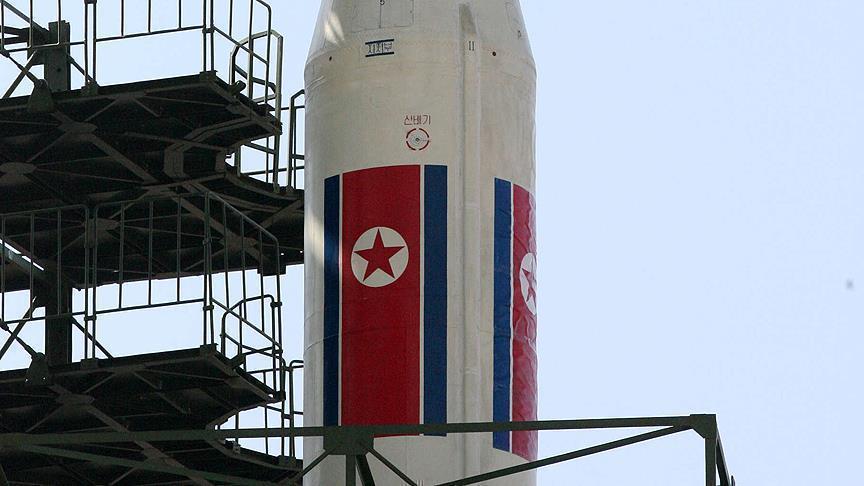US detects North Korean missile launch



The U.S. detected a North Korean missile launch Tuesday, with early indications pointing to an unprecedented intercontinental ballistic missile test.
Defense Secretary James Mattis told reporters at the White House that the missile went higher “than any previous shots they’ve taken” and described the test as a “research and development effort on their part to continue building ballistic missiles that can threaten everywhere in the world”.
South Korea responded swiftly to the launch.
President Moon Jae-in’s office said he called a National Security Council meeting while the South’s military carried out an exercise simulating a “precision” counterattack on North Korea around five minutes after Pyongyang’s missile test.
Seoul’s Army, Navy and Air Force conducted the drill close to the maritime border with the North, according to the Joint Chiefs of Staff.
“Our military is keeping an eye on North Korea’s military activities 24 hours,” the JCS said in a statement carried by local news agency Yonhap.
Mattis said South Korea “fired some pinpoint missiles out into the water to make certain North Korea understands that they could be taken under fire by our ally”.
Just hours earlier, South Korean Unification Minister Cho Myoung-gyon warned that “North Korea could announce its completion of a clear force within one year”.
The North “has been developing its nuclear weapons at a faster-than-expected pace,” Cho told reporters — even amid a 75-day lull in North Korean provocations, which was broken by Wednesday morning’s missile launch.
White House press secretary Sarah Huckabee Sanders also said on Twitter that President Donald Trump “was briefed, while the missile was still in the air, on the situation in North Korea”.
“I will only tell you that we will take care of it. We have General Mattis in the room with us, and we’ve had a long discussion on it,” Trump said in a meeting with the Congressional leadership at the White House. “It is a situation that we will handle.”
The missile was detected at 1:17 p.m. Eastern time (1817GMT) and was launched from Sain Ni, just north of the North Korean capital, according to the Pentagon.
It traveled approximately 1,000 kilometers (621 miles) before crashing into the Sea of Japan within Japan’s Exclusive Economic Zone, spokesman Col. Robert Manning said in a statement.
“We are working with our interagency partners on a more detailed assessment of the launch,” the Pentagon added.
The North American Aerospace Defense Command (NORAD) determined the missile did not pose a threat to North America, U.S. territories or its allies, Manning added.
“Our commitment to the defense of our allies, including the Republic of Korea and Japan, in the face of these threats, remains ironclad. We remain prepared to defend ourselves and our allies from any attack or provocation,” he said.
The launch ends a months-long halt of North Korea’s ballistic missile tests. The last test was of an intercontinental ballistic missile on Sept. 15 that flew over Japan before crashing into the Pacific Ocean.
Secretary of State Rex Tillerson said there is still room for a diplomatic solution to the crisis “for now” as he urged greater action from the international community.
“In addition to implementing all existing UN sanctions, the international community must take additional measures to enhance maritime security, including the right to interdict maritime traffic transporting goods to and from the DPRK,” he said in a statement, referencing the Democratic People’s Republic of Korea, or North Korea.
“The DRPK’s relentless pursuit of nuclear weapons and the means to deliver them must be reversed,” Tillerson noted.
“Together, the international community must continue to send a unified message to North Korea that the DPRK must abandon its WMD (Weapons of Mass Destruction) programs,” he added.
The U.S. and Canada will convene a meeting of the unified UN command for multinational forces which will include South Korea and Japan as well as “other key affected countries” to address ways the international community can counter the North, Tillerson added.
North Korea has test-fired 15 missiles so far in 2017 and conducted its sixth underground nuclear test in September.
During separate phone calls with Japanese Prime Minister Shinzo Abe and South Korea’s Moon, Trump and the leaders agreed that the tests are undermining the North’s security and isolating it from the international community, according to the White House.
*Alex Jansen, Kasim Ileri and Safvan Allahverdi contributed to this report from Seoul, South Korea and Washington respectively.